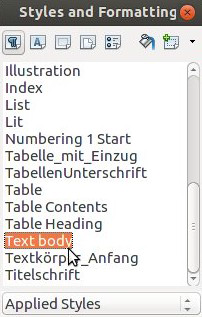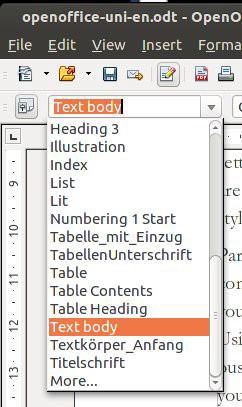Paragraph styles sum up
- Introduction
- Theory
- Document Structure
- Chapter Headings
- Chapter Numbering
- Table of Contents
- Outline
- Navigator
- Text Body
- Paragraph styles overview
- Reusing styles
- Default Page Formatting
- Title Page
- Papers without a Title Page
- Pages with and without numbering
- Roman Page Numbering
- Group Work
- Proofreading
- Numbered lists and bullets
- Line numbering
- Cross-references
- Footnotes
- Bibliography
- Quotes
- Tables
- Charts
- Pictures
- Snapshots
- Presentations & Graphics
- Cross tables (Statistics)
- Extra Long Web Adresses
- Fonts
- Emphasis
- Special Characters
- Non separable combinations
- Shortcut keys
- Mouse clicks
- PDFs
- Saving your files
- Several files open at once
- Search and replace
- Spell Check
- Synonyms
- Document Infos
- Labels and Form letters
- Help
- Installing Program
- Microsoft Word
- Practice I
- Practice II
We have already acquainted ourselves with paragraph styles for headings, for the text body and for the various levels in the table of contents. Other elements such as footnotes, quotes, liter - ature lists and so on all have their own individual styles. You can create new styles to suit your needs. All these various styles form a kind of family tree, the root paragraph style being the one calledDefault. This is the one you should never use, since its purpose is for overall settings, not specific textelements. There are ‘subfamilies’ of styles, e.g. various text body styles.
Illustration 14. Here you see a list of all Applied Paragraph Styles, i.e. those actually used in my text. In the menu bar you can see buttons for the other categories of styles: Characters, Frames, Pages and Lists.
Paragraph styles make life so much easier. They allow for complete uniformity of all types of text. So for instance all your quotes will have the same amount of indentation. Using styles in a systematic way will save you an enormous amount of time and you won’t have to scan through your text any more in search of possible formatting mistakes.
You get to the style list through Format › Styles and Formatting or else simply by pressing F11. At the very bottom of the list you can choose if you want to list all possible styles or only the ones you have applied so far. The latter also appear on the menu bar top left (illustration 15). You can change any existing style by right-clicking it and choosing Modify. If it is a paragraph style you can also simply right click on it inside your text and choose Edit paragraph style. Take note that this is not the same as Paragraph… The latter serves to modify the paragraph in which the cursor is located, whereas the former serves to modify the appearance of all paragraphs related to this particular style.
You can also create a completely new style by right-clicking on any existing style in the list and choosing New. Under the tab Organiser you can choose which style you want to base your new style on. This saves quite a lot of time since you will then only need to modify a few diverging parameters. Using the small black triangle ▼ on the top right hand corner of the pop-up menu you can create a New Style from Selection, meaning a new paragraph style or page style based on the paragraph or page in which your cursor is located at present.
Illustration 15. Top left in menu bar to see all active styles
Paragraph styles are the most common category. But there are other categories: Character Styles (which I use here to highlight Menus and Shortcuts using the font Courier 10pt), Frame Styles, Numbering Styles and most importantly Page Styles to differentiate between numbered and non-numbered pages (see section 16).
“Default Formatting”?
Under the menu Format you will see the option Default Formatting (shortcut Ctrl + m). If you mark text and apply Default Formatting to it, the marked text will loose any formatting you may have applied previously and take all its formatting exclusively from the Paragraph style it belongs to. This is very practical for removing any unwanted hidden formats in a Microsoft Word file. Why the shortcut Ctrl + m? The m possibly stands for “delete Manual formatting”? You should not confuse the term Default Formatting with the term Default paragraph style!

